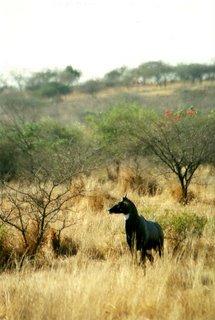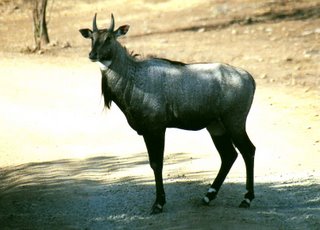 Perhaps the only tropical grassland in India with the status of a national park, Velavadar in Bhavnagar, is 36 kilometres of grasslands and thorn scrub in the southern confines of Gujarat.
Perhaps the only tropical grassland in India with the status of a national park, Velavadar in Bhavnagar, is 36 kilometres of grasslands and thorn scrub in the southern confines of Gujarat. We travelled through this area in search of Asiatic Lions, and although the forests of Sasan Gir were our ultimate destination, I was beginning to get a distinct feeling that we were now entering an area of real, primeval wilderness.
The grasslands were bathed in a suffocating, impenetrable heat haze, and searing temperatures dogged us incessantly, draining our energy before we could even pick up our cameras and get to work. Velavadar is a stronghold of the majestic Black Buck – reputedly the fastest antelope over long distances and a highly protected species – by royal decree.
Having almost been wiped out by overzealous hunters in the last century, the Black Buck is enjoying a comeback of sorts in India, if only through the committed work of local conservationists. The reserve is carefully managed, and the species so precious that they are further protected from their natural predators by the wildlife department. Jackals though, and the extremely rare Indian Wolf still make enough of an impact to strike some kind of equilibrium in the numbers.
We were not staying here for long – there are no lions here – and we only wanted some coverage of the Black Bucks to fill in some back story to the main show. And besides, we had arrived out of the breeding season, so the gorgeous black and white adult males were not being as flamboyant with their advances towards the females – although the dominant stags spent most of their time putting sub-adult males in their place. With no cover from the heat, we were about to leave the black buck and head for the cover of the forests, but then we all stopped what we were doing when a strange figure materialized on the horizon.
Out of the shimmering grass strode one of the most unusual looking animals I have ever seen. The mirage slowly began to take shape and for a moment I believed I was looking at a strange hump-backed, long-necked buffalo. But it was far from a strange, fantastical mutation. This was a very real, and very sacred Blue Bull, or Nilgai to give it its proper name. I have read about Nilgai and seen pictures of them, but to witness one in the wild – it almost seems like an improbable mixture of several different animals…
With a pair of devilish little horns adorning its head and a black beard sprouting from its neck, we were able to identify it as a male. He was uneasy, changing his posture regularly and sniffing the air. His uneasiness was caused by an adjacent herd of lighter-coloured females. His behaviour suggested that at least one of them was in breeding condition. Our presence, all loaded into a big grey Land Rover, may have also been causing him some nerves, so we pulled away, and left him to his potential exploits…
 Full-grown male Nilgai, reputedly are pound-for-pound, one of the strongest antelope species in the world, but I’m not sure how such a statement is either gauged or measured. But what I do know is that they are a very regal-looking animal. The males in particular make an imposing sight. When we finally reached Gir, we came across a number of other individuals – but one battle-worn male particularly stood out from the rest.
Full-grown male Nilgai, reputedly are pound-for-pound, one of the strongest antelope species in the world, but I’m not sure how such a statement is either gauged or measured. But what I do know is that they are a very regal-looking animal. The males in particular make an imposing sight. When we finally reached Gir, we came across a number of other individuals – but one battle-worn male particularly stood out from the rest.Like a proven prize-fighter, one of his horns was dramatically broken, and his thick neck was scarred and streaked from run-ins with rivals or predators, or both.
His beard was long and his blue-black coat positively glistened in the sun – he was quite a striking sight, and he seemed to know it.
This male too was hanging around a female, with calf in tow. She seemed to be pregnant as well, so I’m not sure why the male was hovering around them. But he was on full alert, so mesmerized by scanning the horizon that he totally overlooked our presence.
After a long while, we were distracted by a hunting party of Jackal, and left the trio behind, to trail the jackals deeper into the bush. It was only later on in the afternoon that we found out the reason for the male’s unease.
A small pride of lions had been enjoying their mid-morning siesta about a mile away, and although he couldn’t see them, the old Nilgai could certainly smell the felines. Nilgai are fully equipped to survive in a place with lions and tigers for neighbours. Apart from their bulk, they are capable of attaining prolonged speeds of up to 30 miles an hour, and have very sharp eyesight.
By early evening, we encountered a pair of bachelor bulls, who were in their prime and muscled up like the 500-pound heavyweights they were. But a sudden change in the wind, and they were off, along with the female they were following...
The matriarch lioness had roused her family and they were on the move… As dusk settled, even the formidable Nilgai withdrew from centre stage and sought out the sanctuary of the undergrowth – still the best tactic when a Lion has dinner on its mind…











4 comments:
The Nilgai in the distance certainly looks strange...a bit like two people in a bull costume.
I have not heard nor seen too much Nilgai save for the odd carcass. It is a very interesting creature...and that is coming from someone who is not entirely excited about ungulates.
I suppose you brought the "love thy ungulate" out of me.
Forgive my ignorance, but are those lions the Asiatic ones you were looking for, or another type?
Those Blue Bulls do seem to be a mix of lots of different animals!
Yes - sometimes even tiger food is as interesting as the tigers themselves, Kuba!
Hi Jacki,
Yes - these are the Asiatic Lions. The area we were filming in - Sasan Gir - is their last stronghold - but there are new plans to establish another reserve for them.
Post a Comment